中国文化英文介绍
中国文化介绍英文版Chinese Culture introduction
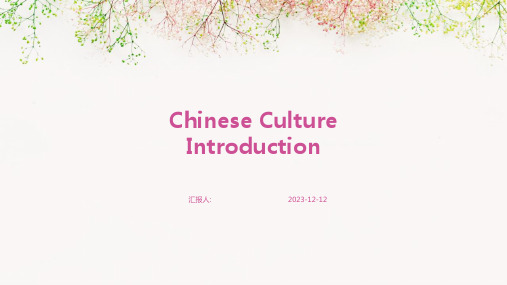
The commonly used techniques and styles in Chinese painting include ink painting, meticulous painting, freehand brushwork, etc., each with its unique aesthetic value and artistic expression.
Chinese Ceramics and Chinese Knives
Chinese porcelain is most famous for porcelain from Jingdezhen, Longquan Kiln, and other places, with a history dating back to the Tang Dynasty.
03
Buddhism and Zen Buddhism have a deep impact on Chinese culture, including Chinese poetry, calligraphy, painting, music, and folk customs They also spread to other countries and regions in the world
The Origin of Chinese Culture
The origin of Chinese culture can be traced back to the Yellow River basin, which is considered the slogan of Chinese civilization The Yellow River is an important river in China that has nurtured the growth of many urban civilizations
介绍中国传统文化英文
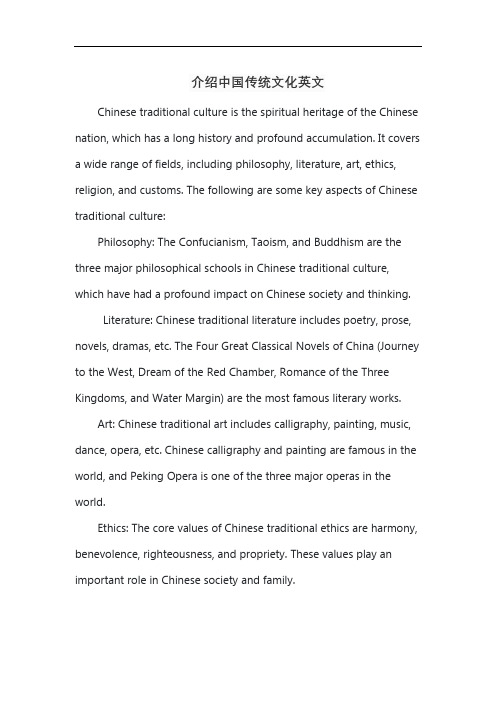
介绍中国传统文化英文Chinese traditional culture is the spiritual heritage of the Chinese nation, which has a long history and profound accumulation. It covers a wide range of fields, including philosophy, literature, art, ethics, religion, and customs. The following are some key aspects of Chinese traditional culture:Philosophy: The Confucianism, Taoism, and Buddhism are the three major philosophical schools in Chinese traditional culture, which have had a profound impact on Chinese society and thinking.Literature: Chinese traditional literature includes poetry, prose, novels, dramas, etc. The Four Great Classical Novels of China (Journey to the West, Dream of the Red Chamber, Romance of the Three Kingdoms, and Water Margin) are the most famous literary works.Art: Chinese traditional art includes calligraphy, painting, music, dance, opera, etc. Chinese calligraphy and painting are famous in the world, and Peking Opera is one of the three major operas in the world.Ethics: The core values of Chinese traditional ethics are harmony, benevolence, righteousness, and propriety. These values play an important role in Chinese society and family.Religion: Chinese traditional religion includes Buddhism, Taoism, and Islam. These religions have had a profound impact on Chinese society and culture.Custom: Chinese traditional customs include Spring Festival, Mid-Autumn Festival, Dragon Boat Festival, etc. These customs reflect the cultural traditions and values of the Chinese nation.In short, Chinese traditional culture is a rich and diverse cultural system that has had a profound impact on Chinese society and the world. It is the spiritual pillar of the Chinese nation and an important part of world culture.。
英文介绍中国传统文化
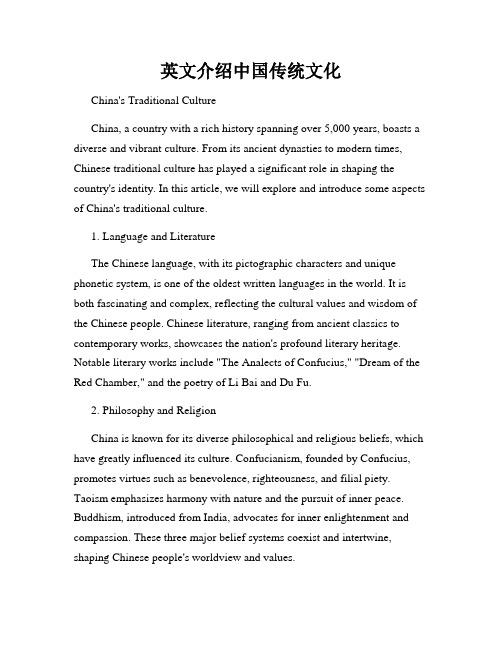
英文介绍中国传统文化China's Traditional CultureChina, a country with a rich history spanning over 5,000 years, boasts a diverse and vibrant culture. From its ancient dynasties to modern times, Chinese traditional culture has played a significant role in shaping the country's identity. In this article, we will explore and introduce some aspects of China's traditional culture.1. Language and LiteratureThe Chinese language, with its pictographic characters and unique phonetic system, is one of the oldest written languages in the world. It is both fascinating and complex, reflecting the cultural values and wisdom of the Chinese people. Chinese literature, ranging from ancient classics to contemporary works, showcases the nation's profound literary heritage. Notable literary works include "The Analects of Confucius," "Dream of the Red Chamber," and the poetry of Li Bai and Du Fu.2. Philosophy and ReligionChina is known for its diverse philosophical and religious beliefs, which have greatly influenced its culture. Confucianism, founded by Confucius, promotes virtues such as benevolence, righteousness, and filial piety. Taoism emphasizes harmony with nature and the pursuit of inner peace. Buddhism, introduced from India, advocates for inner enlightenment and compassion. These three major belief systems coexist and intertwine, shaping Chinese people's worldview and values.3. Traditional FestivalsChina has a wide array of traditional festivals, each with its unique customs and significance. The most well-known is the Spring Festival, also known as Chinese New Year, which marks the beginning of the lunar calendar. During this time, families gather for reunion dinners, exchange red envelopes containing money, and set off fireworks to ward off evil spirits. Other important festivals include the Lantern Festival, Qingming Festival, Dragon Boat Festival, Mid-Autumn Festival, and Double Ninth Festival.4. Traditional ArtsChinese traditional arts cover a broad range of disciplines, including calligraphy, painting, pottery, sculpture, opera, and martial arts. Calligraphy, regarded as a visual art form, embodies a spiritual expression of beauty and harmony. Chinese painting, characterized by brushstrokes and ink washes, often depicts landscapes, flowers, and birds. Traditional Chinese opera combines music, dance, and elaborate costumes to tell stories from Chinese history and folklore.5. Traditional Sports and GamesThroughout history, the Chinese have valued physical health and fitness. Traditional sports and games such as martial arts, table tennis, badminton, and mahjong have become deeply rooted in Chinese culture. Martial arts, such as Tai Chi and Kung Fu, not only promote physical well-being but also encompass a philosophical and spiritual dimension.6. CuisineChinese cuisine, with its diverse regional flavors and cooking styles, is renowned worldwide. From Sichuan spicy hot pot to Cantonese dim sum, each region has its unique culinary traditions. Chinese cuisine emphasizes the balance of flavors, textures, and colors. It includes a wide variety of ingredients and cooking techniques, demonstrating the Chinese people's deep appreciation for food and dining etiquette.ConclusionChina's traditional culture, with its rich heritage and diverse expressions, continues to be an essential part of its national identity. The language, literature, philosophy, festivals, arts, sports, and cuisine embody the values and traditions that have been passed down through generations. Understanding and appreciating China's traditional culture not only enhances our knowledge but also promotes cultural exchange and mutual respect in an increasingly interconnected world.。
介绍中国文化的英语作文

介绍中国文化的英语作文英文回答:China is a country with a rich and diverse culture that dates back thousands of years. Chinese culture is known for its traditions, customs, and values that have been passed down through generations. One of the most important aspects of Chinese culture is the concept of filial piety, which emphasizes the importance of respecting and caring forone's parents and elders. This value is deeply ingrained in Chinese society and is reflected in various customs and rituals, such as the annual Qingming Festival, where people pay respects to their ancestors.Another prominent aspect of Chinese culture is the emphasis on harmony and balance. This is evident in various practices such as traditional Chinese medicine, which focuses on restoring balance within the body to achieve optimal health. Additionally, the concept of yin and yang, representing the balance of opposing forces, is afundamental principle in Chinese philosophy and isreflected in various aspects of Chinese culture, including martial arts, feng shui, and even cuisine.Chinese culture also places a strong emphasis on family and community. Family is considered the cornerstone of society, and there is a strong sense of obligation to support and care for one's family members. This isreflected in traditional Chinese values such as loyalty, respect, and collectivism. For example, the Chinese NewYear is a time for families to come together and celebrate, and it is considered a time for reconciliation and renewalof family ties.In addition to these values, Chinese culture is also known for its rich history and traditions, including its art, music, literature, and cuisine. Traditional Chinese art, such as calligraphy and painting, often reflects the natural world and the harmony of the universe. Chinese music, such as traditional opera and folk songs, is knownfor its melodic and rhythmic complexity. Chinese literature, including classic works such as "The Romance of the ThreeKingdoms" and "Journey to the West," reflects the valuesand beliefs of Chinese society. And Chinese cuisine, withits diverse flavors and regional specialties, is areflection of the country's vast and varied landscape.Overall, Chinese culture is a complex and multifaceted tapestry of traditions, values, and customs that have been shaped by thousands of years of history. It is a culturethat is deeply rooted in the past but continues to evolve and adapt to the modern world.中文回答:中国是一个拥有丰富多彩文化的国家,其文化可以追溯数千年。
中国文化的英文范文
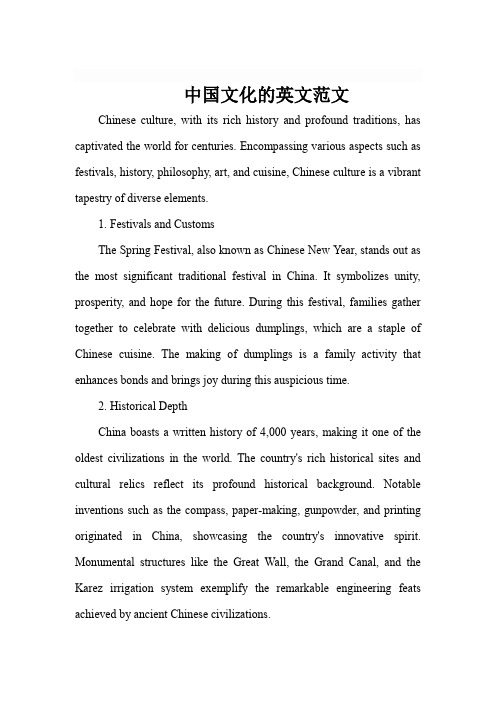
中国文化的英文范文Chinese culture, with its rich history and profound traditions, has captivated the world for centuries. Encompassing various aspects such as festivals, history, philosophy, art, and cuisine, Chinese culture is a vibrant tapestry of diverse elements.1. Festivals and CustomsThe Spring Festival, also known as Chinese New Year, stands out as the most significant traditional festival in China. It symbolizes unity, prosperity, and hope for the future. During this festival, families gather together to celebrate with delicious dumplings, which are a staple of Chinese cuisine. The making of dumplings is a family activity that enhances bonds and brings joy during this auspicious time.2. Historical DepthChina boasts a written history of 4,000 years, making it one of the oldest civilizations in the world. The country's rich historical sites and cultural relics reflect its profound historical background. Notable inventions such as the compass, paper-making, gunpowder, and printing originated in China, showcasing the country's innovative spirit. Monumental structures like the Great Wall, the Grand Canal, and the Karez irrigation system exemplify the remarkable engineering feats achieved by ancient Chinese civilizations.3. Philosophical WisdomChinese philosophy, deeply rooted in Confucianism, Taoism, and Buddhism, has shaped the country's societal values and ethics. These philosophical teachings emphasize harmony, respect, and the pursuit of knowledge, which are reflected in Chinese people's daily lives and social interactions. The wisdom of ancient Chinese philosophers continues to inspire individuals worldwide.4. Artistic ExpressionsChinese art, with its variety of forms such as Tang poetry, Song Ci, calligraphy, blue and white porcelain, and traditional Chinese musical instruments like the erhu and guzheng, demonstrates the country's rich artistic heritage. These artistic expressions have evolved over time, blending traditional and modern elements to create a unique aesthetic that is admired globally.5. Culinary DelightsChinese cuisine is renowned worldwide for its diverse flavors and cooking techniques. From spicy Sichuan dishes to the delicate flavors of Cantonese cuisine, each regional cuisine offers a unique taste experience. The documentary series "A Bite of China" has showcased the stories behind various foods, highlighting the connection between food and local cultures, traditions, and people's lives.In conclusion, Chinese culture is a vibrant amalgamation ofhistorical depth, philosophical wisdom, artistic expressions, and culinary delights. It continues to evolve while preserving its ancient traditions, making it a fascinating and enriching experience to explore.。
中华传统文化英文介绍
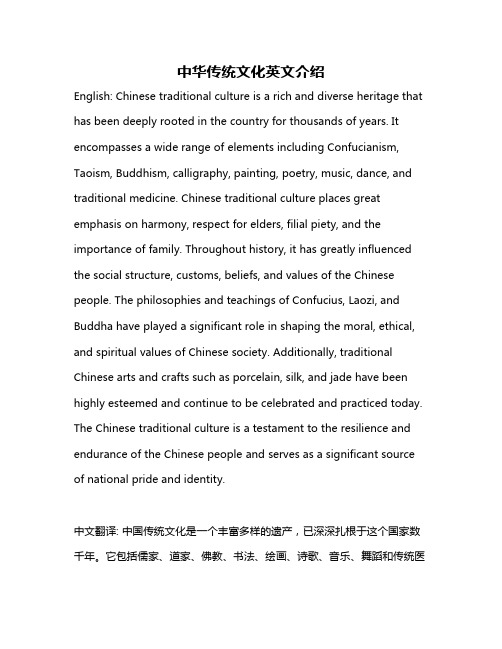
中华传统文化英文介绍English: Chinese traditional culture is a rich and diverse heritage that has been deeply rooted in the country for thousands of years. It encompasses a wide range of elements including Confucianism, Taoism, Buddhism, calligraphy, painting, poetry, music, dance, and traditional medicine. Chinese traditional culture places great emphasis on harmony, respect for elders, filial piety, and the importance of family. Throughout history, it has greatly influenced the social structure, customs, beliefs, and values of the Chinese people. The philosophies and teachings of Confucius, Laozi, and Buddha have played a significant role in shaping the moral, ethical, and spiritual values of Chinese society. Additionally, traditional Chinese arts and crafts such as porcelain, silk, and jade have been highly esteemed and continue to be celebrated and practiced today. The Chinese traditional culture is a testament to the resilience and endurance of the Chinese people and serves as a significant source of national pride and identity.中文翻译: 中国传统文化是一个丰富多样的遗产,已深深扎根于这个国家数千年。
介绍中国传统文化的英文作文万能句子
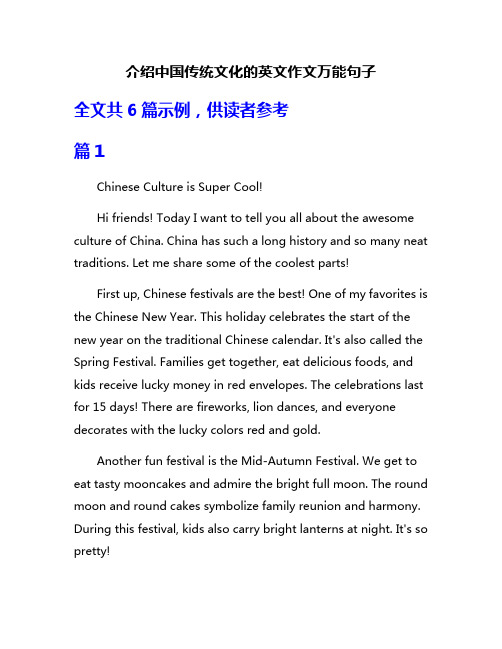
介绍中国传统文化的英文作文万能句子全文共6篇示例,供读者参考篇1Chinese Culture is Super Cool!Hi friends! Today I want to tell you all about the awesome culture of China. China has such a long history and so many neat traditions. Let me share some of the coolest parts!First up, Chinese festivals are the best! One of my favorites is the Chinese New Year. This holiday celebrates the start of the new year on the traditional Chinese calendar. It's also called the Spring Festival. Families get together, eat delicious foods, and kids receive lucky money in red envelopes. The celebrations last for 15 days! There are fireworks, lion dances, and everyone decorates with the lucky colors red and gold.Another fun festival is the Mid-Autumn Festival. We get to eat tasty mooncakes and admire the bright full moon. The round moon and round cakes symbolize family reunion and harmony. During this festival, kids also carry bright lanterns at night. It's so pretty!Speaking of food, Chinese cuisine is out of this world! There are so many flavors and regional styles. My favorites are dumplings, noodles, and Peking duck. Mmm, my mouth is watering just thinking about it! An important part of the meal is using chopsticks to eat. It takes practice, but once you get the hang of it, chopsticks are super cool to use.Chinese arts and crafts are amazing too. One example is calligraphy - the beautiful art of fancy writing and brushwork. The tools are a brush, ink stone, and rice paper. Writing the characters looks almost like a dance! Another craft is paper folding called zhezhi. You can make clever designs like dragons and phoenixes just by folding pieces of paper in special ways.Then there are the famous Chinese inventions that changed the world! Things you might use every day like paper, printing, the compass, and gunpowder were first created in ancient China. Can you imagine your life without those handy items? Pretty crazy, right?Those are just a few highlights of the rich Chinese culture. There is still so much more I could discuss, like traditional Chinese medicine, martial arts, silk making, jade carving, and ancient philosophical teachings. China has contributed countlesscustoms, innovations, and wisdom to human civilization over its 5,000 year history.I feel so lucky to be able to learn about my cultural roots from a young age. The Chinese traditions of honor, discipline, creativity and diligence will help guide me to become a good person. While modern life is rapidly changing, it's important to keep these long-standing values alive. I hope more people around the world can come to appreciate the splendor and significance of Chinese culture!篇2My Favorite Chinese TraditionsHi there! My name is Xiao Ming and I'm 10 years old. I live in Beijing with my mom, dad, and little sister Mei Mei. Today I want to tell you about some of my favorite parts of Chinese culture that my family celebrates and practices.One of the biggest traditions is Chinese New Year! This is the most important holiday we celebrate each year. Everything starts with a huge cleaning of the whole house to sweep away bad luck from the old year. Then my mom buys lots of yummy snacks and fresh fruit. We decorate with red lanterns, couplets with good luck sayings, and paintings of the zodiac animal for that year.On New Year's Eve, our whole family gets together for a huge feast called the Reunion Dinner. We have all kinds of delicious dishes like dumplings, noodles for long life, whole steamed fish for abundance, and sweet rice balls. After dinner, we stay up late setting off firecrackers and fireworks at midnight to ring in the new year!The next day, it's tradition to wake up early and dress in new clothes from head to toe for good luck. Kids like me get hung bao, which are little red envelopes with money inside as a gift. We're not allowed to sweep or take out trash for a couple weeks so we don't sweep away the good luck. For two weeks, there are lion dances, temple fairs, and dragon dances in the streets to celebrate!Another big tradition is the Mid-Autumn Festival. This holiday honors the big, bright, beautiful full moon. A couple weeks before, my grandma teaches my sister and me to make mooncakes. These are thick pastries stuffed with lotus seed paste or other fillings, and they are shaped like the full moon.On the night of the festival, my whole family gets together to eat mooncakes and sip tea under the moon. We try to spot the jade rabbit on the moon's surface! My favorite part is carrying brightly glowing lanterns shaped like animals through the parkwith all my cousins. Shanghai has the biggest lantern festival I've ever seen.Speaking of lanterns, another fun tradition is for the Lantern Festival at the end of New Year celebrations. My dad is an artist, so he always makes the most beautiful lanterns for us to hang up around the house and courtyard. When I was little, we would go to temple fairs and watch dragon dances weaving through the streets between bright, swaying lanterns. Now that I'm older, I get to carry a lantern myself in the evening parade!Chinese culture is filled with so many other amazing traditions too. I love hearing the legends behind them from my grandparents. Like the story of the household gods who check on each family before New Year and report to the Jade Emperor in heaven. Or the tale of Zhi Nu the cloud weaver and Niu Lang the cowherd, whose forbidden love is honored on Qixi or the Double Seventh Festival.Another favorite is Qingming Festival in the spring, when we visit our ancestors' graves, burn incense, and make offerings of their favorite foods and fresh flowers. It reminds me of the importance of honoring those who came before us.There are so many brilliant Chinese inventions that are still used today too! Printing, paper making, the compass,gunpowder, the abacus for math—all of these amazing things originated in ancient China. We even had the first robot! It was an automatic wine server made of bamboo and string.I'm also very proud of Chinese arts and crafts like calligraphy, painting, paper cutting, jade carving, kite making, pottery, and embroidery. My aunt is an incredible painter and she teaches me Chinese brush painting techniques. I'm trying to learn to write with a brush and ink too.Chinese medicine is fascinating as well. Practitioners use herbs, acupuncture, massage, and practices like tai chi and qigong to promote health and balance in the body. My grandpa does tai chi in the park every morning and says it's a great way to start the day.There are just so many brilliant accomplishments, beautiful arts, delicious cuisine, ancient philosophies, and fun celebrations in Chinese culture. I feel very lucky to be able to participate in these rich traditions. Maybe you'd like to experience some too! Let me know if you have any other questions.篇3Traditional Chinese Culture is Super Cool!Hey there! I'm going to tell you all about the awesome traditional culture from China. It's been around for thousands of years and has so many fascinating parts to it. Get ready to learn some really neat stuff!First up, let's talk about Chinese characters. They look like beautiful little pieces of art, with each one representing a word rather than just a letter sound. Writing in Chinese characters takes a ton of practice, but once you get the hang of it, it's almost like painting a mini picture every time you write something down. There are so many characters too - tens of thousands! My grandparents can read and write way more than I can.Speaking of my grandparents, a big part of Chinese culture is respect for elders and ancestors. We have special holidays just for honoring our older family members and those who came before us. During festivals like Qingming, we visit the graves of our ancestors, clean them up, and leave offerings of food, flowers and incense. On the Lunar New Year, kids get lucky red envelopes with money inside from the grown-ups. It's a way of passing on good fortune.Then there are all the amazing Chinese arts and crafts. Calligraphy is the beautiful handwriting of Chinese characters.True masters can make the ink flow and dance across the paper. Chinese painting has been around for ages, capturing landscapes, flora and fauna with detailed brushstrokes. My favorite is probably paper cutting though - creating intricate designs by folding and snipping away at colorful paper. It's almost like magic!I can't talk about Chinese culture without mentioning the food! Oh man, the food is out of this world delicious. Every region has its own special dishes and flavors. In the north, they love doughy things like dumplings and noodles. In the south, the cuisine features lots of rice and seafood. Then you've got Sichuan food which is crazy spicy but so tasty. My mouth waters just thinking about it!Two philosophies that are really important in Chinese thinking are Taoism and Confucianism. Taoism teaches ideas like going with the flow and finding balance and harmony in nature. Confucianism is more about ethics, morals, and social roles. Showing respect, working hard, and being a good person are key Confucian values. Both have influenced Chinese culture immensely over the centuries.I could ramble on forever about Chinese martial arts like kung fu, traditional medicine practices, Beijing Opera with all itsbright costumes and masks, or Chinese inventions like the compass, gunpowder, and printing. But I'll stop here so I don't overload your brain!Chinese culture is just endlessly fascinating to me. From the very first script carved into oracle bones to the modern skyscrapers of cities like Shanghai, it has such an amazingly long and rich history. Preserving traditions while also adapting to new times is something the Chinese people have done brilliantly over the millennia. I'm so fortunate to be part of this wonderful heritage. If you ever get the chance to experience aspects of traditional Chinese culture, I highly recommend it!篇4Chinese Culture is Awesome!Hi friends! Today I want to tell you all about the amazing culture of China. There's just so much to share about the oldest continuous civilization on Earth. Get ready to learn some super cool stuff!Let's start with Chinese writing. Did you know Chinese characters are one of the oldest written languages still in use? The earliest written characters date back over 3,000 years! Modern Chinese has tens of thousands of characters, whichoriginate as small pictures representing objects, ideas or sounds.I think it's awesome how each little squiggle holds such deep meaning.Chinese arts and crafts are renowned worldwide for their beauty and craftsmanship. Take ceramics for example - Chinese potters were the first to develop fired glazes, way back in the Shang Dynasty over 3,500 years ago! They made gorgeous glazed stoneware in vibrant colors like jade green and sapphire blue. Chinese silk is another famous export, originally reserved only for imperial royalty. It comes from the silkworm, and its production was a closely guarded secret for centuries.Speaking of secrets, let me tell you about Chinese martial arts! Styles like kung fu, with its rapid kicks and punches, actually originated as military training over 2,000 years ago. Masters studied not just combat, but meditation, philosophy and traditional medicines too. So cool!Chinese philosophy has had a huge impact on culture over the millennia. There's Confucianism, which emphasizes ethics, propriety and social harmony. Confucius was a wise teacher who lived around 500 BC. His philosophy guides relationships, from family to government. Then there's Taoism, focused on livingsimply and in harmony with nature. The famous Taoist Book of Changes is over 3,000 years old!No introduction to Chinese culture would be complete without mentioning the amazing architecture. The Forbidden City in Beijing is a massive 180-acre palace compound with nearly 1,000 buildings! It was home to 24 emperors during the Ming and Qing dynasties. With its red walls, yellow glazed roof tiles, white marble and intricate carved wood, it's a breathtaking example of traditional palace architecture.And then there are the amazing festivals! Chinese New Year is the biggest, with red lanterns, fireworks, dumplings and giving out red envelopes with money inside for good luck. TheMid-Autumn Festival celebrates the fall harvest with mooncakes and colorful lanterns. During Qingming Festival, families visit ancestor graves to pay respects. The Dragon Boat Festival has super exciting boat races and eating zongzi, sticky rice wrapped in bamboo leaves!Oh man, I could go on and on about China's rich heritage. From jade carvings to shadow puppetry, from traditional medicine to the games of go and mahjong, there's just so much awesome stuff! Four thousand years of continuous history have created one of the most vibrant and profound cultures on ourplanet. I hope you've enjoyed learning a bit about the wonders of Chinese civilization. It really is something every kid should know about. Thanks for reading, and let me know if you have any other questions!篇5China Has Such Cool Traditions!Did you know that China is one of the oldest civilizations in the world? It has a really rich culture filled with amazing customs, celebrations, and philosophies that have been passed down for thousands of years. Let me tell you about some of the coolest traditions from my awesome country!One of the biggest holidays in China is Chinese New Year. It's kind of like Christmas, but way more exciting! The celebration lasts for 15 whole days. On New Year's Eve, families get together for a huge feast with dishes like dumplings, noodles, fish, and sticky rice cakes. We decorate our houses with red lanterns, couplets, and paper cuts. The color red is super lucky. At midnight, we set off a ton of firecrackers and fireworks to scare away evil spirits. How awesome is that?For the next two weeks, we visit relatives and friends, eat delicious foods, watch dragon and lion dances, and get redenvelopes filled with money! My favorite part is whenthewhole neighborhood comes alive with festivities. There are dragon parades with people dressed up in vibrant costumes juggling balls and ribbons. It's such a joyful, lively celebration of the new year.Speaking of dragons, they are very important in Chinese mythology and culture. They symbolize power, strength, and good luck. You see dragon images and motifs everywhere - on buildings, clothing, artwork. Chinese dragons look way cooler than Western dragons too. Ours have long, snake-like bodies covered in scales, with four legs and expressive faces. Some have deer-like antlers or flowing manes. Ancient rulers even used the dragon symbol to represent their imperial power.Another super important tradition is the philosophy of yin and yang. It's the idea that all things in the universe have two opposing but complementary forces - the yin (dark, feminine, passive) and the yang (light, masculine, active). These energies need to be balanced and harmonious for there to be order in the world. The yin yang symbol, with the swirl of black and white teardrops, represents this concept. It reminds us that within each opposing force contains a seed of the other. Pretty deep for such a simple design, right?I can't forget to mention some Chinese martial arts, which are over 2,000 years old! Kung fu movies with guys doing crazy kicks and punches are popular worldwide. But the practice of kung fu is not just about fighting. It emphasizes moral ethics, spiritual discipline, and finding inner peace. Some of thebest-known styles are Shaolin kung fu, with its intense training at the ancient Shaolin Buddhist monastery, and tai chi, with its slow, graceful movements. Martial arts masters have almost superhuman abilities - they can smash concrete with their heads, walk on sharp nails, and use secret pressure points to defeat opponents!Those are just a few highlights of China's awesome cultural heritage. There's so much more I could tell you about - traditional Chinese medicine, calligraphy, opera, literature, crafts, and architecture. Just exploring Beijing's Forbidden City palace or walking along the Great Wall gives you a sense of China's grand history and traditions. I feel really lucky to come from such an ancient, rich civilization. Don't you think Chinese culture is amazing? I can't wait to learn more about it as I get older!篇6My Awesome Chinese CultureChina is an amazing country with a super long history and lots of awesome culture! I love learning about the traditions of my homeland. Here are some of the coolest parts of Chinese culture:FoodYum, yum, yum! Chinese food is the best. We have so many delicious dishes and snacks. My favorites are dumplings, noodles, and Peking duck. Dumplings are little pouches stuffed with tasty fillings like pork and vegetables. You can boil them, steam them, or fry them. Noodles come in long strings that you slurp up. And Peking duck is a whole roasted duck with crispy skin that gets brushed with a sweet sauce. My mouth is watering just thinking about it!Another Chinese food tradition is to use chopsticks instead of forks and spoons. Chopsticks are two skinny sticks that you hold in one hand to pick up food. It takes practice to get good at using chopsticks, but once you learn, it's fun!FestivalsChina celebrates a lot of exciting festivals every year. My favorite is the Chinese New Year! It's also called the Spring Festival. This holiday lasts for 15 days and is a time for familyreunions, eating special foods, and setting off fireworks and firecrackers. Houses get decorated with red lanterns, couplets, and papercuts. Kids receive red envelopes filled with money as gifts. The loud fireworks are supposed to scare away evil spirits for the new year.Another big celebration is the Mid-Autumn Festival. It happens when the moon is roundest and brightest in the fall. Families get together to admire the full moon, eat mooncakes (a dense sweet cake), and share the legend of Chang'e, the mythical lady on the moon.Arts and CraftsThe traditional arts and crafts of China are awesome! I love the ink wash paintings of landscapes with their soft brushstrokes and splashes of black ink. Chinese calligraphy, or brush writing, is also beautiful. The calligraphers have to practice for years to perfect the elegant flowing strokes.One of the coolest Chinese crafts is paper folding and cutting. People fold and snip away at colorful paper to create intricate designs called paper cuts. They are usually designs of characters, animals, or flowers with lots of tiny, detailed cuts. The papercuts are used to decorate windows or lanterns for festivals.Another traditional craft is making clay figurines. Little statues of people, animals, and mythical creatures are molded and painted with bright colors and patterns. During holidays, every household will display these vibrant clay figurines.Beliefs and StoriesChina has a lot of fascinating traditional beliefs and folk tales that have been passed down for thousands of years. Many of the stories try to teach good values like being kind, working hard, and respecting your elders.For example, there is the legend of the Jade Rabbit. As the story goes, a poor rabbit once jumped into a fire to provide food for the hungry. The rabbit's noble sacrifice was so brave that the gods were touched. They immortalized the rabbit by placing its image on the moon as a symbol of selflessness.Other myths tell about deities and supernatural creatures. The Dragon King is said to be the ruler of all waters and ability to control rain and floods. The Phoenix is a magical bird that appears only in times of peace and prosperity as a symbol of harmony. I love hearing about these magical tales!China has many traditional beliefs about luck, fortune, and symbolism too. The numbers 8 and 9 are considered very lucky,while 4 is unlucky. Certain colors, animals, and objects are seen as auspicious symbols for good luck, wealth, longevity, or fertility. For instance, goldfish represent abundance, while cranes signify long life.Traditional ClothingChinese people have such awesome traditional styles of dress. Many outfits feature bright colors, elaborate patterns, and intricate knots or fastenings.For ladies, there is the qipao or cheongsam dress. This is a tight-fitting dress with a high collar and fancy patterns and frog button closures up the sides. Another beautiful women's garment is the long trailing dress with billowing sleeves called an ao dai.For men, the traditional look is a long silk robe called a changshan. It has a mandarin collar and may be plain or decorated with embroidery and knotted buttons.Many of the clothes, accessories, and shoes incorporate symbols like dragons, phoenixes, peonies, or geometric shapes that were thought to bring good luck and fortune. Even the knots and fasteners could carry meanings of health, wealth, or long life.I feel so proud learning about the incredible traditions, arts, and culture of my Chinese heritage. China has such a depth of rich customs that have been carefully passed down from ancient times until today. I hope you found some parts of it interesting too! Let me know if you want to hear more awesome details about life in the Middle Kingdom.。
中国传统文化介绍(英文版)
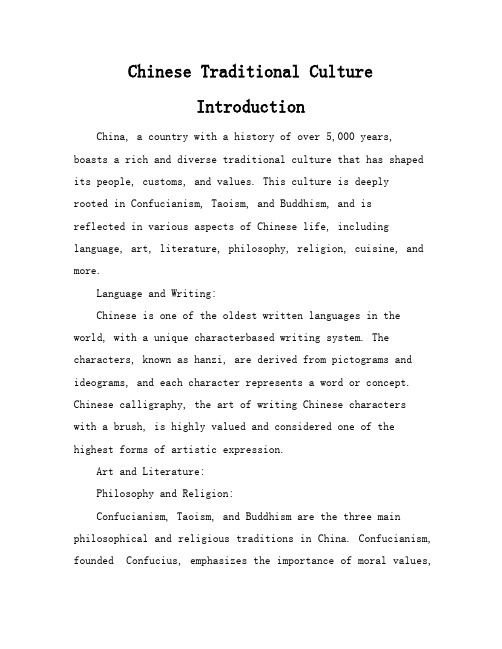
Chinese Traditional CultureIntroductionChina, a country with a history of over 5,000 years, boasts a rich and diverse traditional culture that has shaped its people, customs, and values. This culture is deeplyrooted in Confucianism, Taoism, and Buddhism, and isreflected in various aspects of Chinese life, including language, art, literature, philosophy, religion, cuisine, and more.Language and Writing:Chinese is one of the oldest written languages in the world, with a unique characterbased writing system. The characters, known as hanzi, are derived from pictograms and ideograms, and each character represents a word or concept. Chinese calligraphy, the art of writing Chinese characterswith a brush, is highly valued and considered one of the highest forms of artistic expression.Art and Literature:Philosophy and Religion:Confucianism, Taoism, and Buddhism are the three main philosophical and religious traditions in China. Confucianism, founded Confucius, emphasizes the importance of moral values,social harmony, and filial piety. Taoism, founded Laozi, emphasizes the pursuit of harmony with nature and the Tao, or the Way. Buddhism, which originated in India, focuses on the Four Noble Truths and the Eightfold Path as a means to achieve enlightenment and escape suffering.Cuisine:Chinese cuisine is one of the most diverse and flavorful in the world, with a wide variety of regional styles and dishes. Some of the most famous Chinese dishes include Peking duck, dim sum, hot pot, and dumplings. Chinese cooking techniques are also diverse, including stirfrying, steaming, boiling, and roasting.Festivals and Celebrations:China has a rich tradition of festivals and celebrations, many of which are based on the lunar calendar. Some of the most important festivals include the Spring Festival (Chinese New Year), the MidAutumn Festival, the Dragon Boat Festival, and the Lantern Festival. These festivals are celebrated with traditional customs, such as lighting lanterns, eating special foods, and watching fireworks.Traditional Medicine:Traditional Chinese medicine (TCM) is a holistic system of medicine that has been practiced for thousands of years. TCM emphasizes the balance of yin and yang, and the use ofherbal remedies, acupuncture, and other treatments to promote health and wellbeing.Conclusion:Chinese traditional culture is a treasure trove of knowledge, wisdom, and beauty. It continues to influence the lives of people in China and around the world, and is a valuable resource for understanding the history and development of human civilization.ContinuedArchitecture and Gardens:Chinese architecture is renowned for its intricate designs, use of wood, and emphasis on harmony with nature. Traditional Chinese buildings often feature curved roofs, red columns, and decorative elements such as dragons and phoenixes. Chinese gardens, known for their balance of water, rocks, plants, and architecture, are designed to create a serene and contemplative atmosphere.Music and Dance:Chinese music has a long history, with various instruments such as the guqin (a sevenstringed zither), erhu (a twostringed fiddle), and pipa (a fourstringed lute). Traditional Chinese dance is also diverse, ranging from优雅的宫廷舞到欢快的民间舞,每一种舞蹈都有其独特的风格和意义。
- 1、下载文档前请自行甄别文档内容的完整性,平台不提供额外的编辑、内容补充、找答案等附加服务。
- 2、"仅部分预览"的文档,不可在线预览部分如存在完整性等问题,可反馈申请退款(可完整预览的文档不适用该条件!)。
- 3、如文档侵犯您的权益,请联系客服反馈,我们会尽快为您处理(人工客服工作时间:9:00-18:30)。
中国文化英文介绍
1. 元宵节:Lantern Festival
2. 刺绣:embroidery
3. 重阳节:Double-Ninth Festival
4. 清明节:Tomb sweeping day
5. 剪纸:Paper Cutting
6. 书法:Calligraphy
7. 对联:(Spring Festival) Couplets
8. 象形文字:Pictograms/Pictographic Characters
9. 人才流动:Brain Drain/Brain Flow
10. 四合院:Siheyuan/Quadrangle
11. 战国:Warring States
12. 风水:Fengshui/Geomantic Omen
13. 铁饭碗:Iron Bowl
14. 函授部:The Correspondence Department
15. 集体舞:Group Dance
16. 黄土高原:Loess Plateau
17. 红白喜事:Weddings and Funerals
18. 中秋节:Mid-Autumn Day
19. 结婚证:Marriage Certificate
20. 儒家文化:Confucian Culture
21. 附属学校:Affiliated school
22. 古装片:Costume Drama
23. 武打片:Chinese Swordplay Movie
24. 元宵:Tangyuan/Sweet Rice Dumpling (Soup)
25. 一国两制:One Country, Two Systems
26. 火锅:Hot Pot
27. 四人帮:Gang of Four
28. 《诗经》:The Book of Songs
29. 素质教育:Essential-qualities-oriented Education
30. 《史记》:Historical Records/Records of the Grand Historian
31. 大跃进:Great Leap Forward (Movement)
32. 《西游记》:The Journey to the West
33. 除夕:Chinese New Year’s Eve/Eve of the Spring Festival
34. 针灸:Acupuncture
35. 唐三彩:Tri-color Pottery of the Tang Dynasty/The Tang Tri-colored pottery
36. 中国特色的社会主义:Chinese-charactered Socialist/Socialist with Chinese characteristics
37. 偏旁:radical
38. 孟子:Mencius
39. 亭/阁:Pavilion/ Attic
40. 大中型国有企业:Large and Medium-sized State-owned Enterprises
41. 火药:gunpowder
42. 农历:Lunar Calendar
43. 印/玺:Seal/Stamp
44. 物质精神文明建设:The Construction of Material Civilization and Spiritual Civilization
45. 京剧:Beijing Opera/Peking Opera
46. 秦腔:Crying of Qin People/Qin Opera
47. 太极拳:Tai Chi
48. 独生子女证:The Certificate of One-child
49. 天坛:Altar of Heaven in Beijing
50. 小吃摊:Snack Bar/Snack Stand
51. 红双喜:Double Happiness
52. 政治辅导员:Political Counselor/School Counselor
53. 春卷:Spring Roll(s)
54. 莲藕:Lotus Root
55. 追星族:Star Struck
56. 故宫博物院:The Palace Museum
57. 相声:Cross-talk/Comic Dialogue
58. 下岗:Lay off/Laid off
59. 北京烤鸭:Beijing Roast Duck
60. 高等自学考试:Self-taught Examination of Higher Education
61. 烟花爆竹:fireworks and firecracker
62. 敦煌莫高窟:Mogao Caves
63. 电视小品:TV Sketch/TV Skit
64. 香港澳门同胞:Compatriots from Hong Kong and Macao
65. 文化大革命:Cultural Revolution
66. 长江中下游地区:The Mid-low Reaches of Yangtze River
67. 门当户对:Perfect Match/Exact Match
68. 《水浒》:Water Margin/Outlaws of the Marsh
69. 中外合资企业:Joint Ventures
70. 文房四宝(笔墨纸砚):"The Four Treasure of the Study" "Brush, Inkstick, Paper, and Inkstone",。
